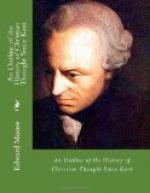[Footnote 5: Wernle, Einfzhrung in das Theologische Studium, 1908, v. 204.]
In the long run, the simpler view did not maintain itself. If false gods and demons were expelled, it was the God Jesus who expelled them. The more modest faith believed that in the man Jesus, being such an one as he was, men had received the greatest gift which the love of God had to bestow. In turn the believer felt the assurance that he also was a child of God, and in the spirit of Jesus was to realise that sonship. Syncretist religions suggested other thoughts. We see that already even in the synoptic tradition the calling upon the name of Jesus had found place. One wonders whether that first apprehension ever stood alone in its purity. The Gentile Churches founded by Paul, at all events, had no such simple trust. Equally, the second form of faith seems never to have been able to stand alone in its peculiar quality. Some of the gnostic sects had it. Marcion again is our example. The new God Jesus had nothing to do with the cruel God of the Old Testament. He supplanted the old God and became the only God. In the Church the new God, come down from heaven, must be set in relation with the long-known God of Israel. No less, must he stand in relation to the simple hero of the Gospels with his human traits. The problem of theological reflexion was to find the right middle course, to keep the divine Christ in harmony, on the one side, with monotheism, and on the other, with the picture which the Gospels gave. Belief knew nothing of these contradictions. The same simple soul thanked God for Jesus with his sorrows and his sympathy, as man’s guide and helper, and again prayed to Jesus because he seemed too wonderful to be a man. The same kind of faith achieves the same wondering and touching combination to-day, after two thousand years. With thought comes trouble. Reflexion wears itself out upon the insoluble difficulty, the impossible combination, the flat contradiction, which the two views present, so soon as they are clearly seen.




